Gender
Operation Decoy
In August 1962, New York City cops began patrolling the streets at night while dressed as women. The idea was to trap would-be muggers.But not all the decoy cops were successful at apprehending the muggers. Patrolman Victor Ortiz got hit over the head by a mugger, lost his gun, and his assailant got away.
Update: Author Erika Janik discusses Operation Decoy in her book Pistols and Petticoats: 175 Years of Lady Detectives in Fact and Fiction. She places it within the context of an ongoing resistance within the police department during the mid-twentieth century to the idea of having female police officers:
Some even went so far as to suggest that male officers could simply dress as women for undercover work. In 1962, eight male officers did just that in order to trap muggers and rapists in New York City. "We want our men to look like housewives, not like Hollywood stars," explained Inspector Michael Codd, head of the tctical force. Twenty-seven-year-old patrolman Victor Ortiz wore white sandals, orange tapered pants, and a beige padded sweater on top of a bright print blouse. On hand to help the officers get ready were two policewomen, Caryl Collins and Dolores Munroe. The women stood by in their official uniforms as the men posed for the TV and newspaper cameras. Why teaching men to wear heels and put on lipstick was deemed more useful than simply deploying policewomen seems a question the reporters never asked. It's true that decoys did get attacked as part of these operations (that was the point), but all officers worked in teams with detectives standing by to apprehend suspects. In this instance, two of the disguised policemen had their purses snatched in Central Park and seven people were arrested in the overnight anti-mugging operation.

Orlando Evening Star - Aug 25, 1962

Greenville News - Aug 24, 1962
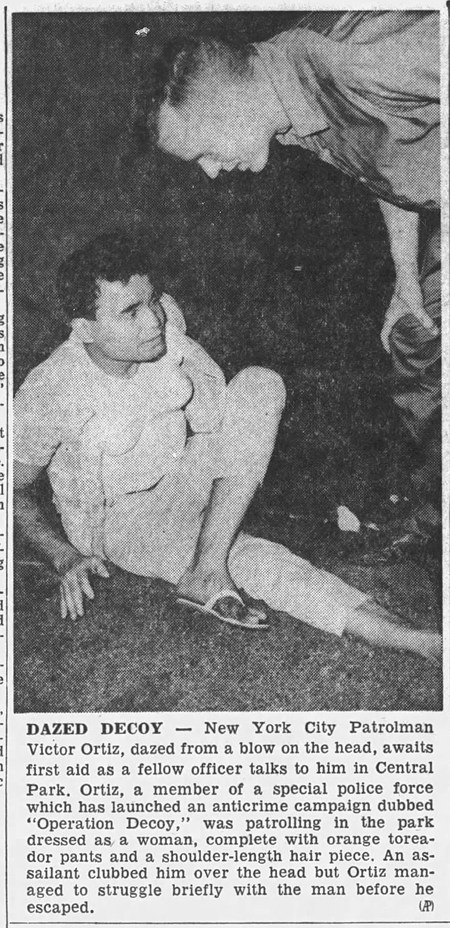
Allentown Morning Call - Aug 28, 1962

Posted By: Alex - Tue Jan 30, 2018 -
Comments (2)
Category: Police and Other Law Enforcement, Gender, 1960s
Women are teachable
A guide published by the Radio Corporation of America circa 1943.
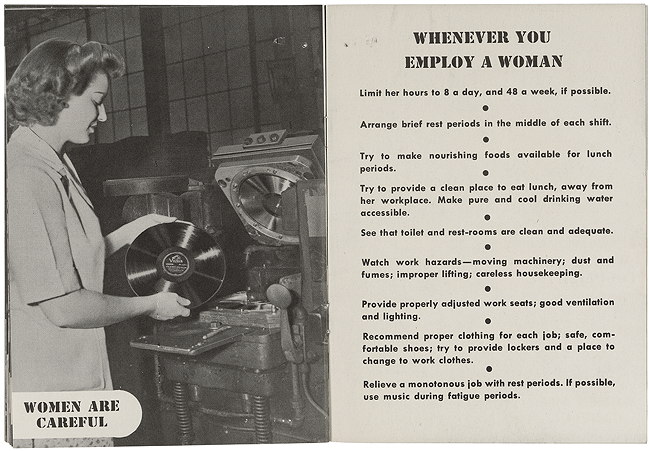


Source: imgur via reddit.
Posted By: Alex - Sun Jan 28, 2018 -
Comments (6)
Category: Jobs and Occupations, Gender, Women, 1940s
Ada Leonard and Her All-Girl Orchestra
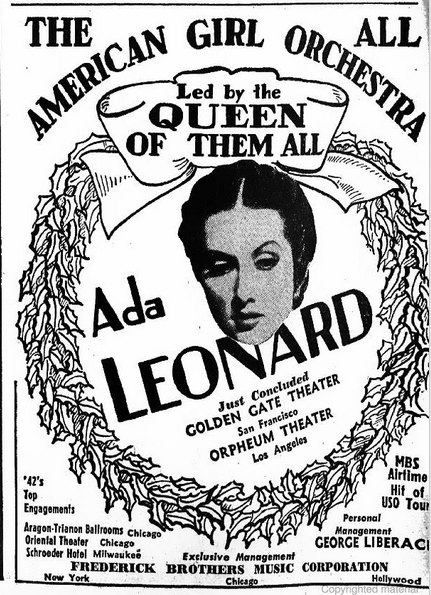
Wikipedia page here.
Posted By: Paul - Sat Aug 05, 2017 -
Comments (4)
Category: Music, Gender, Women, 1940s
Beer For Her
A Czech brewer has introduced Aurosa, a "beer for her":How exactly does one transform a beer into a "beer for her"? Apparently you put it into a pink-hued bottle and charge more for it.

This isn't the first attempt to make a beer specifically for women. Back in 2011, there was Chick Beer.
More info: eater.com.
Posted By: Alex - Sun Jul 23, 2017 -
Comments (6)
Category: Gender, Women, Alcohol
Battleship - the gender role edition
Milton Bradley debuted the board game Battleship in 1967, and the illustration on the box of that first edition has become somewhat notorious because it shows a father and son playing the game while the mother and daughter in the background do the dishes.That choice of scene wasn't any kind of accident. The game was deliberately marketed as a "father and son game." The phrase was constantly repeated in early advertisements for the game. The whole idea of "father and son games" has now, of course, disappeared from board games.
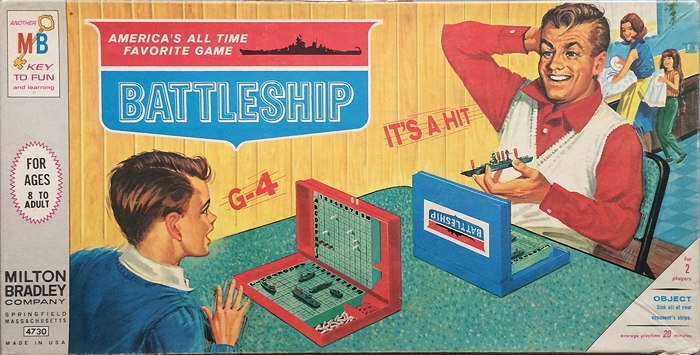
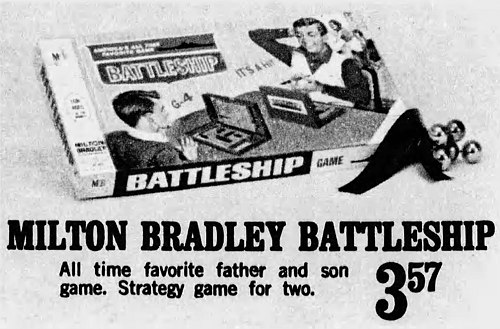
The Akron Beacon Journal - Nov 30, 1969
Posted By: Alex - Sun Jun 25, 2017 -
Comments (5)
Category: Games, Gender, 1960s
A license to kill
Maybe they were hoping to appeal to the serial killer demographic.The ad ran in Playboy magazine, 1964.

The after shave is briefly mentioned in Playboy and the Making of the Good Life in Modern America, by Elizabeth Fraterrigo:
Posted By: Alex - Sat May 20, 2017 -
Comments (2)
Category: Advertising, Gender, 1960s
Only man never to have seen a woman
October 1938: 82-year-old Mihailo Tolotos died. He had lived his entire life in Greece's Mt. Athos monastery, which women were (are) not allowed to enter, and he was therefore believed to have been the only man in the world never to have seen a woman — or rather, the only man never to have been in the presence of a woman (except his mother, who died giving birth to him), because as the folks over at The Straight Dope point out, anyone who is born blind will have never seen a woman.
The Edinburg Daily Courier - Oct 29, 1938
In 1949, the Nixon Furniture Company featured the story of Mihailo Tolotos in one of their ads. They were worried that just as Tolotos had never seen a woman, perhaps the readers of the Raleigh Register hadn't seen all of Nixon's new furniture.

The Raleigh Register - Jan 7, 1949
Posted By: Alex - Wed Apr 20, 2016 -
Comments (7)
Category: Gender, Men, Women, 1930s
The New Science of Same-Gender Attraction
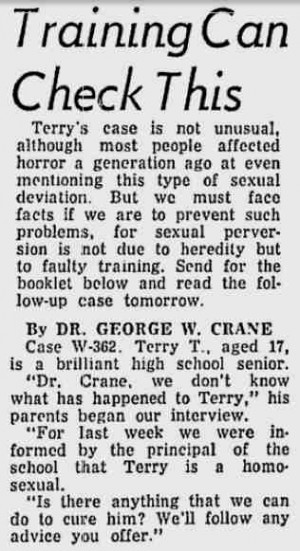
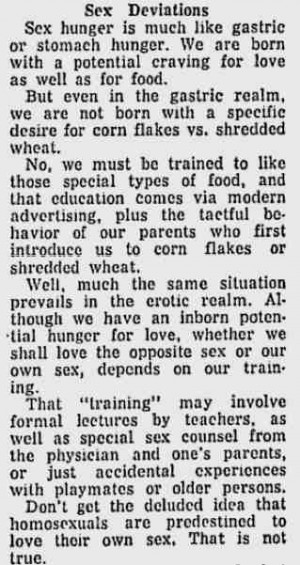
[Read left to right columns above, then left to right below]
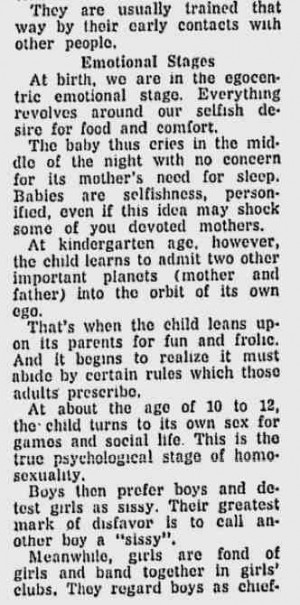
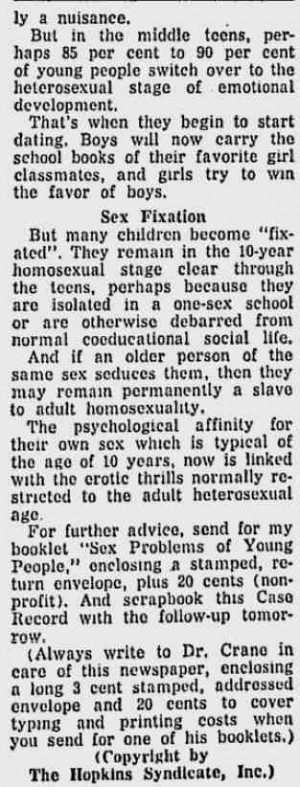
"New," that is, for 1957.
Posted By: Paul - Wed Oct 31, 2012 -
Comments (8)
Category: Sexuality, Gender, Teenagers, 1950s
Gender-Differentiated Toy Film Projectors
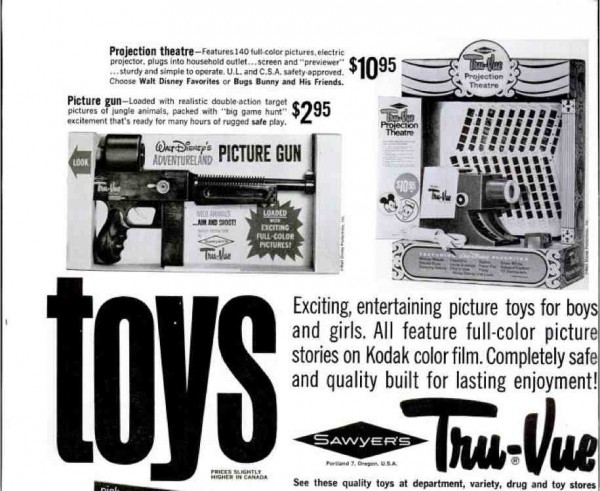
Guess which model is for boys, and which for girls....
Original ad here.
Posted By: Paul - Sat Aug 25, 2012 -
Comments (9)
Category: Movies, Toys, Gender, 1960s
Science as a girl thing
EU bureaucrats, in their great wisdom, decided that the way to encourage teenage girls to pursue a career in science was not by appealing to their intelligence and curiosity, but rather by flashing images of high heels, lipstick, and makeup at them, along with the tagline: "Science, It's a Girl Thing." The inevitable outrage followed. (telegraph.co.uk)It was my impression (though I don't have any data at hand to back it up, so I could be totally mistaken) that in some sciences, such as biology and medicine, women are fairly equally represented (perhaps even at risk of becoming over-represented). So in those cases science already is a "girl thing." It's the physical sciences, such as electrical engineering, that still have trouble attracting women.
Posted By: Alex - Fri Jun 29, 2012 -
Comments (5)
Category: Science, Gender

| Who We Are |
|---|
| Alex Boese Alex is the creator and curator of the Museum of Hoaxes. He's also the author of various weird, non-fiction, science-themed books such as Elephants on Acid and Psychedelic Apes. Paul Di Filippo Paul has been paid to put weird ideas into fictional form for over thirty years, in his career as a noted science fiction writer. He has recently begun blogging on many curious topics with three fellow writers at The Inferior 4+1. Contact Us |




